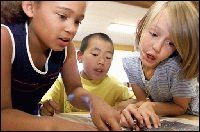 |
 |
 |
 |
| HOME Site index
    |
Sunday, September 23, 2001 -
12:00 a.m. Pacific AMERICA MOVES AHEAD: Special section | Photo galleries | How to help School kids produce newspaper to help them boost writing scores By Keith
Ervin
Hayes and faculty members responded by creating a journalism academy. And by year's end, students had produced four issues of a newspaper, North Beach Chronicle, and a year-end literary magazine, The Seal-attle Press. Students' writing skills rose, and so did their WASL scores. When 2001 results were announced Wednesday, 58 percent of fourth-graders passed the writing test. That's solid improvement from the previous year, but hardly a remarkable achievement for a student body whose demographics are an educator's dream. Nestled into the Crown Hill neighborhood where a few Norwegian flags mingle with the many American flags, North Beach is a school whose students have most of the advantages that typically spell academic success. Only a few students live in poverty, come from non-English-speaking countries, or qualify for special education. Four out of five live in two-parent households. "These kids should be blowing the tops off test scores. They're bright and they're capable," Hayes said. The idea of a journalism academy was a natural one for Hayes, who previously advised two award-winning high-school newspapers in Texas. North Beach teachers agreed to the idea despite initial reservations. Using Parent Teacher Association funds, Hayes hired freelance writer and part-time Seattle Post-Intelligencer editor Leah Kohlenberg to run the program. Kohlenberg organized a journalism conference, where a panel of professional journalists introduced fourth- and fifth-graders to the fundamentals of the craft. Students brainstormed story ideas and practiced interviewing under the watchful eyes of the pros. Students now write the articles, take the photographs and sell the ads for the self-supporting North Beach Chronicle. They sell up to $600 in ads to local businesses for each issue. About 1,000 copies are distributed free in the school and in local businesses. Third-graders will be trained in journalism this school year, along with older students. This year the school will buy new photographic and video equipment with a $10,000 grant from Brian Cartmell, founder of Internet domain-registry firm e-NIC. North Beach Communications, or NBC, is a real-world endeavor that teaches children about writing. "When you're a journalist you have to write really fast. It's pretty hard. You always have to get things right or else people might get mad at you," said fifth-grader Lindsay Wakayama, 10. "I learned it's best to write what it's about, then get into details in the second paragraph," said fifth-grader Kisa Yonker, 10. North Beach Chronicle staff members said journalism has made writing more fun, but it hasn't been easy. When one boy phoned the Seattle-King County Health Department for information about a flu outbreak, he was heard to say in exasperation, "You don't have any doctors? ... All I need is a quote about the flu!" He was transferred to the department's public-relations office, and he completed his story. "The kids are given a lot of independence to go out and do this process. That's when it gets crazy. You know you have to let them do it," Kohlenberg said. When some 50 students began reporting their first stories, they scattered through the school "like a covey of quail," Hayes said. Their first stories "were pretty rough," but the quality of writing improved after students and teachers critiqued the first edition, teacher Steve Sanders said. If students don't meet their deadline, they've learned, their articles won't get into the paper. They've become accustomed to having Kohlenberg return their first drafts to them for additional reporting and rewriting. In a story about an educational game known as Life and Death, reporters Malcolm Yates and Amanda Henritze wrote this lead: When fifth-grader Ryan Wisniewski saw his good friend Sean Daley in the woods last month, he greeted him in the only way possible. He ate him. "This is all kids' work — not parents' work, kids' work. Kids can be smart," fifth-grader Yonker said. To what extent the journalism academy is responsible for North Beach's rise in test scores isn't certain. Students scored even better on WASL writing two years ago, before last year's dip. In a small school like North Beach, where only 50 students took the WASL last year, differences in the student body can cause scores to fluctuate from year to year. Changes in teaching staff or teaching methods also can produce changes. The school's math and reading scores have been consistently high, with 74 percent of students meeting the math standard and 90 percent meeting the reading standard last year. Among the fourth graders in Sanders' fourth- and fifth-grade combination class, who were deeply involved in the newspaper, 83 percent met the WASL writing standard. Only 44 percent in the school's other fourth-grade class, whose teacher had little interest in the journalism program, passed. That teacher has left the school. Kim Kommers, the PTA president, doesn't need test scores to see the benefits of the journalism academy. She calls the program "incredible," noting that her third-grade son now reads the newspaper every day. "It's not this random skill that doesn't seem to be related to what happens in life," Kommers said. "I think this has all the ingredients of being a great curriculum. It's just started; the best is yet to come." Keith Ervin can be reached at 206-464-2105 or kervin@seattletimes.com.
|
| ||||||||||||||||||||||||||
|
| |||
| SeattleAreaHomes.com |
 | ||
|
| |||
